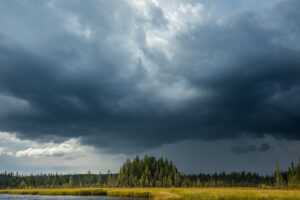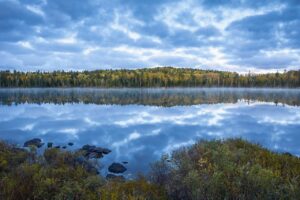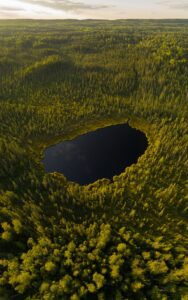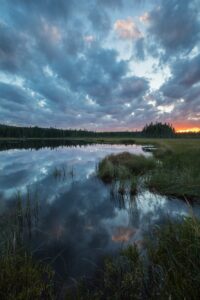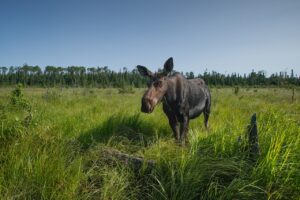Fog enveloped the stillness of the lake and surrounding forest, limiting my visibility to 20 yards and sharpening my auditory sense. I paddled slowly and silently, hoping to encounter my first moose in the Boundary Waters. I had planned this solo excursion with the sole intent of photographing the giant aquatic cervid, but defeat was taking hold after extreme physical exertion and the revelation that this trip was likely a bust. Regardless, I forced myself roll out of my sleeping bag at 5:00 am, and continue my search because failure in the world of wildlife photography outnumbers success by 10:1. As I rounded a bend in the narrow lake I paused and strained to see through the fog when I heard a crash 50 yards in front of me. It was a moose.
I couldn’t see it yet, so I used the snapping of branches to mask my deep paddle strokes as I attempted to close the gap. It was a stroke of luck, I had never encountered a moose moving so clumsily through the forest, most of the time they just silently appeared. After five strong strokes I secured my paddle and glided towards an emerging silhouette of a young bull moose. It was at this instance, almost a decade ago, that my greatest wildlife obsession was born.
Mysticism best defines an encounter with a moose in the boreal forest.
How is that such a large animal can move silently through such dense forests? Their ability to be equally comfortable on land and in water leaves me awestruck. This fascination has sent me down many rabbit holes, resulting in hundreds, if not thousands of hours spent immersed into topographic maps, scouring satellite imagery, and scouting lakes, swamps, and suitable corridors. The funny thing is this: I know I am not the only one. Moose draw Minnesotans like a magnet. If they call you as they do me, the solution is simple: understand the basic needs of moose, dedicate the time, and you will find them. It has been over a decade since my first encounter with a Minnesotan moose and to this day I still invest hundreds of hours each year searching for them. My success rate has increased dramatically through understanding the basic biological requirements of this species, and it is rare to not have a sighting. When searching for moose, there are three things to consider: seasonality, suitable habitat, and food sources. Through this process, I had an incredible 36 hours late last June.
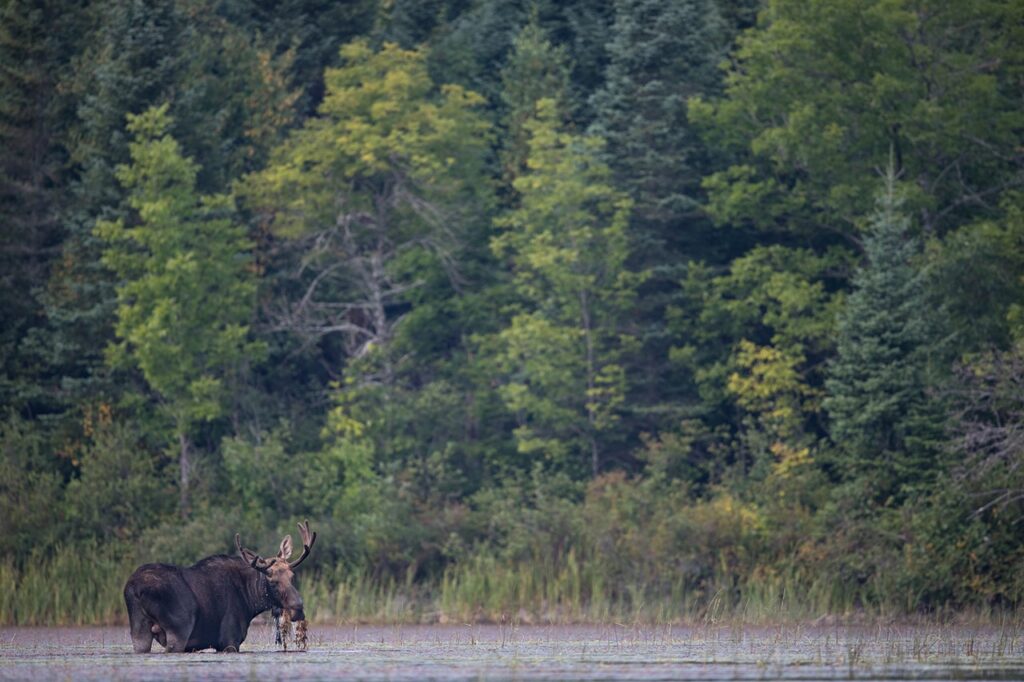
After five years of bushwhacking, tracking and deploying remote cameras, I had honed in on multiple pockets of great moose habitat. Last summer I went on a short trip specifically targeted at moose. I planned out each day thoroughly and focused on micro-regions with a high density moose population. On the first evening I encountered two bull moose as I drove through Isabella, a fleeting sight, and in an area that I hadn’t seen a moose in almost a decade. As I continued north I reached my destination for the last hour of light. I found two more moose, both cows, from longer distances. A great start, but not what I was after and no pictures.
I awoke at 4:30 am the following morning and right off the bat I encountered a cow and calf.
I hopped in my car and drove to the next location and startled two young bulls emerging from a stand of young pines. I went another half mile to a beaver pond where there appeared to be a log floating in the middle. That log soon raised its head out of the water to reveal that it was a large cow moose. I spent 10 minutes watching her feed when she abruptly left the pond and disappeared into a stand of young pines. Not a minute later her head peered through the boughs and she softly vocalized. Two young calves rose from the sedges lining the adjacent shore and swam to their mother.
I was elated, I had seen 7 moose within an hour and a half! I sat there reflecting on the morning when another cow emerged from the opposite shore from where the other cow and her calves had disappeared. As she waded closer, they emerged, she too had twin calves! Was it the presence of the second cow that had driven the first from the water? What were the chances that two cows, both with twins, would use the same beaver pond within minutes of one another, not mention seeing 10 moose before I was fully awake? I spent the remainder of the day nestled in the vegetation lining the beaver dam with a book, hoping they would return to the water, but they never did.
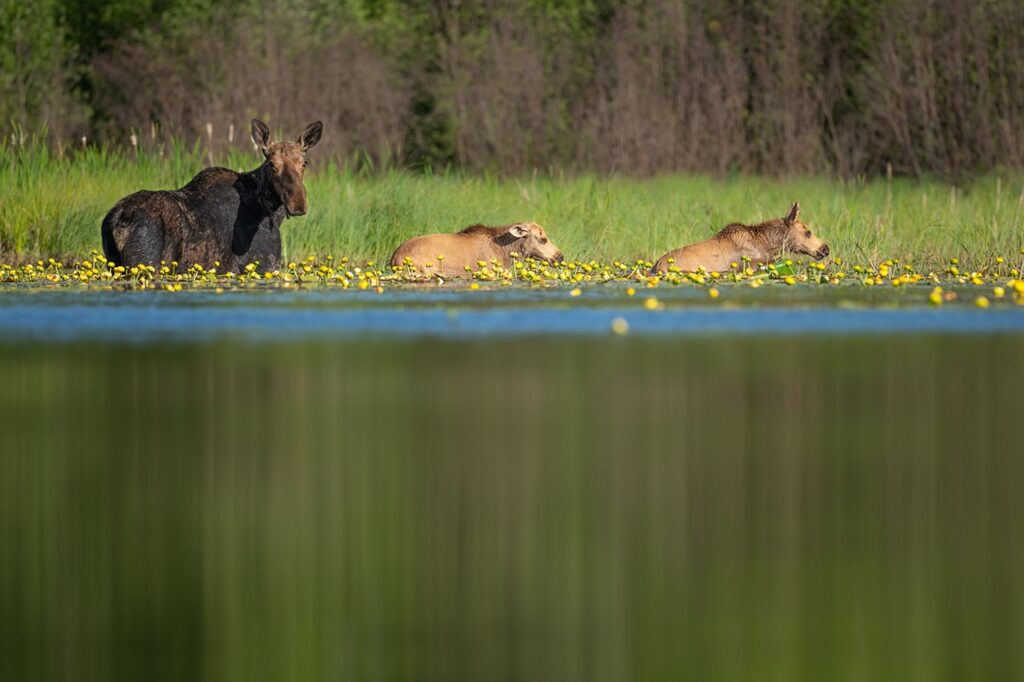
The following morning, the last of my whirlwind trip, I had the most intimate encounter yet. I was near Trails End of the Gunflint Trail, an area famed for a healthy moose population, but I had never seen one. As I approached Seagull Creek I wished for a moose to be wading in the snaking creek and to my shock there was. There she stood, 30 yards from the bridge, and it was so early that I had her all to myself. For once my obsession had paid off and resulted in 15 moose in a day and a half!
This year I took the same approach and I revisited the areas that had resulted in such great success. Although I didn’t see the numbers I had last year, I found a lot of moose, and most of which were in the same general vicinity as last year. These areas harbor great habitat, but that will not always be the case. As the forests mature, the moose will move on to find more suitable habitat. When I am searching for moose I am looking for young regenerating forests, much like the end of the Gunflint.
The disturbances that leveled these forests 20 years ago created prime browsing sites for the moose. This coupled with plethora of shallow lakes, creeks and rivers provides ample habitat for them to thrive. However, these forests will age and the habitat will become less desirable over time. This is why I continually search for new habitat.
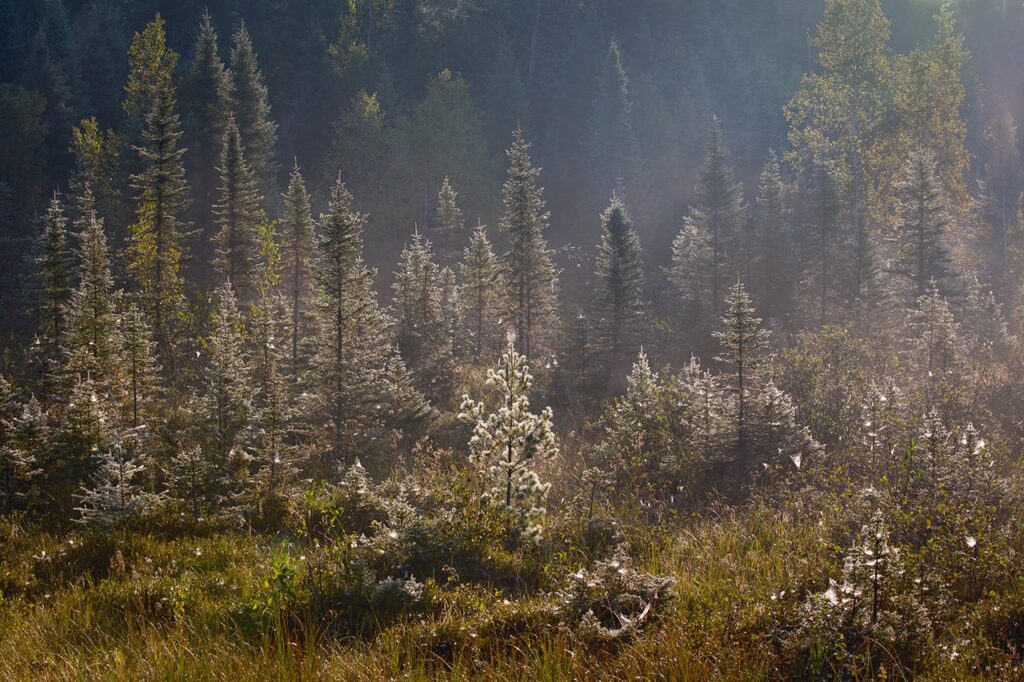
I often look for new sites of disturbance. This can include fire, blow-down, or logging sites.
Once I locate these new areas I invest my time in the ones that are adjacent to creeks, shallow lakes, beaver ponds, and lowland black spruce bogs. It is these hyper-specific areas that I concentrate my efforts. For me, this is just as enjoyable as seeing the moose. Immersing myself into their habitat and reading the land gives me a greater understanding of the animals and how they use the region. For instance, just by examining the gait of their stride and the impression of their tracks I can discern whether they were walking or running.
Examining how vegetation lays on game trails can illuminate the direction in which they were traveling. During the rut I look for scrapes on the ground and bark rubbed off of trees as indicators that a bull is present. All of these subtle, easily missed signs pinpoint that you’ve found a great location. This is where you invest your time. Sunrises and sunsets, time and time again will eventually lead to an encounter. The final and most important thing to consider is the fact that moose spend over 90% of their time in forests. Very little time is spent foraging in the water and that coincides with late spring and early summer for two reasons. First, the water provides an escape from biting insects. Second, the aquatic vegetation they eat is high in calcium, which greatly aids with antler growth for bulls and lactation for cows. So if you want an encounter on the water, go when the bugs are at their worst!

Searching for moose is an investment and definitely a labor of love, but the rewards are so much more than moose. A large portion of my north woods portfolio has been created while searching for moose. All of those hours spent searching at dawn and dusk has presented me with amazing weather conditions, light and other wildlife species.
I’ve watched major storms roll over lakes, dramatic displays of fog, ruffed grouse display, and wolves prowling for the very moose I was looking for. By setting out with a singular goal of locating moose, I have grown to understand the entire region and how many of its inhabitants interact with the landscape. The biggest reward for me is being able to read the story of the boreal forest landscape. While I may not always have encounters with species I am after, I am able to envision them in my mind’s eye through the signs they leave behind. Those visions are what I continually chase.
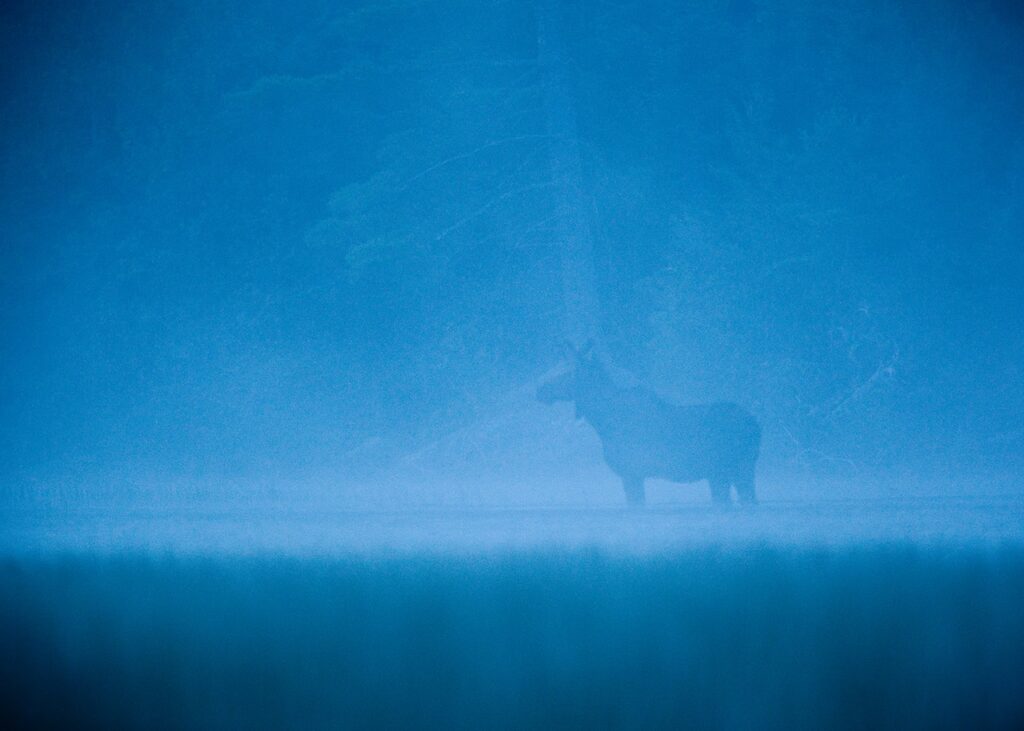
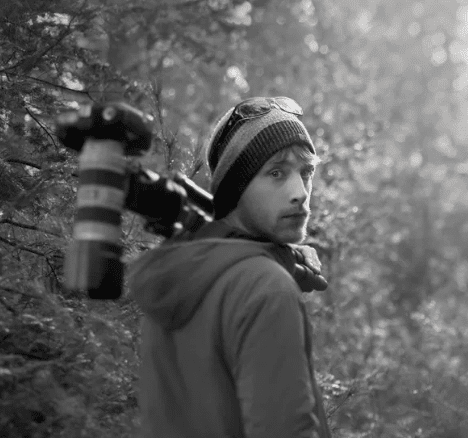
MORE INFORMATION:
More about moose in the Quetico-Superior, Boundary Waters, Voyageurs








